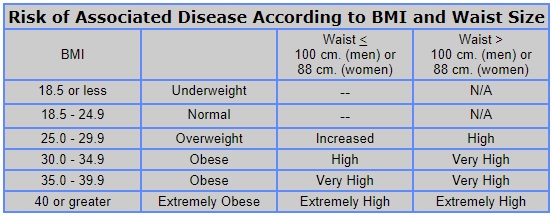BMI Calculator
The BMI or body mass index was developed in the mid 1800's by physicians to study "fatness" and "thinness" in populations rather than percent body fat itself. The BMI is frequently used to determine how much one's body weight departs from a norm based on that individual's height. The excess weight may be due to body fat, but can also be affected by other factors such as muscularity, and body type.
BMI = mass(kg) 2
(height(m))
Studies have shown that BMI as calculated from an individuals weight and height correlates to accurate methods of measuring body fat directly such as underwater weighing and dual energy xray absorptiometry (DXA) . This is an inexpensive way of screening the general population for identifying those with increased risk of developing health problems related to obesity.
Enter your weight and height into the boxes below and click on "calculate" to calculate your body mass index.
BMI Calculator:

Calculator for kids and teens
Interest in measuring body fat began in the 1800's as obesity began to
become a health issue in the industrial world. It was initially
developed to look at large populations and not for individual
diagnoses; however, quickly became widely used by individuals and
physicians alike. This measure is simply a way of classifying sedentary
individuals into categories based on a "fatness" or "thinness". For
these sedentary individuals, a score of 20 to 25 suggests an optimal
weight. A score of under 20 suggests they're underweight, and a score
of over 25 suggests they are overweight.
A problem with this score is that it is proportional to mass; however,
is inversely proportional the person's height squared. If you were to
compare someone twice as tall to a short individual, their mass should
naturally increase by the cube (volume), then the body mass would not
stay the same. Tall people may therefore have a score that is higher
than it should be.
Another problem with this score is that muscle weighs more than fat.
So, someone with a muscular physique will have a high score even though
body fat could be low.
The science of trying to calculate the exact body composition of an
individual is imprecise at best.
Techniques such as:
- underwater weighing
- dual energy xray absorptometry (DEXA)
- use of skin fold measurements
All of these estimates have the potential for error. Increases in BMI
may be caused by gains in either adipose weight or lean body weight.
Hence, using the BMI to estimate body fat is inaccurate in populations
that are very muscular. Rather than identifying obesity, it is
better used as a tool to identify heaviness.
Although the body mass index calculator is a reasonably accurate method
of estimating percent
body fat in sedentary individuals, the rapid changes in weight and
height amongst children aged two to twenty don't allow for valid
prediction of body fat. The potential for false positives when
estimating obesity
amongst children may be more problematic when using
the BMI alone to categorize children or adolescents as obese.